Posted by
Susan Sharma
on
May 12, 2007

A comparison of 14,000 human and chimpanzee genes by researchers at the University of Michigan, U.S, shows that the forces of natural selection have had the greatest impact on our ape cousins. Humans and chimps followed different evolutionary paths from
a common ape ancestor about 5 million years ago. Both underwent changes as the fittest survived to pass their genes on to future generations.
But the U.S study shows that the humans possess a "substantially smaller" number of positively-selected genes than chimps. This may be because the original human population was very small-which would have reduced the effectiveness of natural selection. Instead,"genetic
drift" -the random survival of genetic mutations rather than their preservation by the laws of natural selection -was likely to have been more important for humans.
"These observations refute the anthropocentric view that a grand enhancement in Darwinian selection underlies human origins." scientists wrote in the Journal
Proceedings of the National Academy of Sciences.
Source: Daily Mail, London
|
Posted by
Susan Sharma
on
May 11, 2007
Researchers estimate the captive elephant figures in India to be around 5000, while the official figures are 3500. Ambiguity in numbers and a ban on interstate trade has pushed elephant trade underground.
Kerala and Assam have now appealed to Central Govt. to simplify rules of trade. Kerala has also passed rules for captive elephant management. "Project elephant" is on way to mocrochip captive elephants in order to have a database for tracking animals.
All the above and opening up elephant corridors could be the only way to save these pachydems in the wild!
Source: Times of India
|
Posted by
Bijesh
on
April 30, 2007

Distance from Bangalore: 125 Kms
Suitable for: A weekend outing close to nature.
Activities: Joy fishing, Coracle ride, River side / Mountain trekking.
One thing which stands vivid in your memory above all will be the hospitality of the staff. Kudos to the team…
So what if it’s not the season time…so what if the greenery has given ways to the golden dry color spread across….so what if the sun was brawny enough to boil the cauvery water…WE HAD A BLASTING TIME…..
With no mobile phones or televisions to bother you, it’s an absolute cutoff from the outside world. (Infact, to know who won the world cup cricket, we had to wait and ask a visitor who checked in the next day.).Winding road which goes down to the JLR resort
is an attraction by itself. We, 5 guys in a black Scorpio, reached the place by 1.30 Afternoon. Major attraction of this place is off course fishing. Along with professional anglers, even the amateurs can try their luck in joy fishing. Since it’s the “catch
and release” policy which is followed, no worries on damaging the eco system of the river too…
Coracle ride on cauvery is not to be missed. Go round and round and click as much photos as you can…. Be sure you are abiding to the rules and regulations. Major one being the usage of life jackets which are provided by JLR. Staff will not let you in to
the water with out the same.
Let me upload few pics for you all.
A word of caution: It’s a tough n rough terrain, so if you are off to this place in your “lovely lady” kinda vehicle, you’re gonna regret. Road will budge only in front of toughies like a Scorpio or a Jeep. Especially the last few kilometers of downhill
windings.
|
Posted by
Susan Sharma
on
April 15, 2007

" .there is very little evidence to show that videos are used in the classroom, especially at primary and upper primary level, though impact can be huge considering the visual memory of children at that early stage. However, videos are used by institutions
at higher levels: I had the chance to attend a programme on ’Forced Migration’ organized by Jamia Milia Islamia, New Delhi and we were shown documentaries and films on displaced people and refugees, followed by a discussion. It was a very good experience since
it actually provoked questioning about the problems and issues. The impact is everlasting........
........First and foremost, there is a need to develop documentaries, videos and films on issues like environment protection, health, social learning and so on, where students can be taught through examples from their neighbourhood. It would not only make them
aware and sensitize them but would also develop articulation and comprehension skills. Learning can be more fun. "
Geeta Verma
Jawaharlal Nehru University
New Delhi
"Schools are not uniform entities. There are schools and schools. Most of the time, local communities have no control over it. There have been several initiatives such as the Village Educational Committees which are supposed to input into and control the school
bureaucracy. But the power structures in the village are such that all these committees, especially in areas where the poor and powerless live, have never allowed them to have any control over them.
We run a school called Green School which is a five year school for the poorest – mainly dalits. In this school we have used various kinds of videos, but not the ones produced by children. Because the Project Method, which we normally use in the school, is
a very slow process and takes a lot of time. We have developed child-reporters integral to their learning, but they work on photo cameras and tape recorders with which we produce wall-papers on each of the projects.
Bringing in video for this (in spite of the fact that we have abundant video resources within DDS) proves very expensive, slow and needs a lot of attention. Though one might start with a video or two in the beginning, to keep this process going might be very,
very difficult for rural communities and rural schools.
At one point of time when our school was collaborating with some Municipal schools in London, our children produced some short videos to explain their families, their agriculture, their festivals and their contexts to English children in a series of ‘video
journals’. One video called ‘MY SCHOOL’ was a fascinating one bringing out how children from deprived rural families see their school and their education.
Many years ago, when I was a TV producer working for SITE, I produced very location specific, participatory videos for primary school children in rural areas of Karnataka and Andhra Pradesh. But it was a huge programme backed up by several institutions such
as state educational institutions, state governments of AP and Karnataka and the Government of India, as well as ISRO (Indian Space Research Organization). Even with that backing, the way schools used the video was a big sham. In AP, hundreds of thousands
of video players and TV sets are kept in school cupboards for years: there is no enthusiasm at all to use them.
All these are very complex issues hinging upon the power of teachers in their schools (I am using this in a negative sense because teachers often abhor any extra work and are backed by their powerful unions], the power of the community to take control, as well
the interest of the community to engage in these issues.
At the end of it all, all these innovations suit the elite schools and not the community schools in rural areas which need a whole transformation that needs the collaboration of multiple agencies.
In summary, let me say that while in theory video in schools is a very good thing, it is extremely difficult to get into action on that. I am quite pessimistic."
P V Satheesh
Deccan Development Society
Hyderabad
Dr. PV Satheesh was one of the pioneers of the SITE programme.
SITE (Satellite Instructional Television Experiment), the ISRO-NASA satellite TV project
Source:
ICT for Development Community, Education Community" <se-ictd_se-ed@solutionexchange-un.net.in>
|
Posted by
Bijesh
on
April 13, 2007

Wayanad
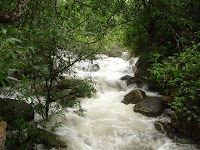
Unruffled nature…… Undisturbed peace of mind……Untouched natural beauty...If this is what you are searching for to have an ideal breakaway from the normal frantic schedules….Then here it is….. It’s Wayanad for you.
We were 5 guys in the herd and the intension was to hit the road to a serene world. And we found one…. Though little bit skeptical bout going in to the forest during off season, we decided to take a chance. And believe me; we never regretted the decision through
out the journey.
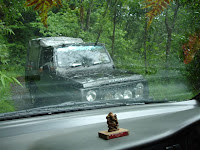 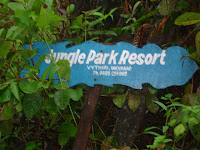
We started from Bangalore by 6.30AM in a Silver Tavera and yes the journey was fun (With the new Bangalore Mysore highway in place, we saved few hours also.).Good part of the journey was that on the way we had to cross Bandipur forest . Drizzle added to
the fun as we stopped on the way to enjoy the tranquil atmosphere, And we were really hoping to see a tusker. But naaaah…It was just silent wilderness.
After crossing the border to Kerala, after a few stretches of winding roads which deserves a special mention for the quality and maintenance, we saw the board on the left side of the road which read Jungle Park resort.
We took the kachha road and as we moved on, on either sides we
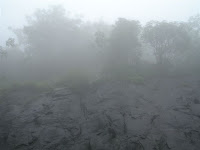 could see only greenery, greenery of the forest
with leaves drenched in the rain. Cool breeze running allover gave us a boost both for our tired body n soul. As we moved on, we could see a gushing stream right in front, crossing the so called kachha road. could see only greenery, greenery of the forest
with leaves drenched in the rain. Cool breeze running allover gave us a boost both for our tired body n soul. As we moved on, we could see a gushing stream right in front, crossing the so called kachha road.
Driver was hesitant but took the vehicle ahead through the same. We stopped the vehicle and had a nice time splashing the cold water on our face n body. We took some photographs and again started moving towards our destination, Jungle park resorts.

We were surprised to see the mist which covered the entire visibility at times. We stopped again to take photographs of the mystique nature and then moved on to reach Jungle part resort by 11 O Clock. Even at that time the fog was pretty strong in the jungle
and it was marvelous to see huge trees in the background with misty fog all over the place.
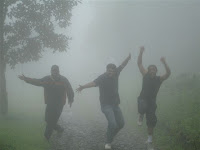 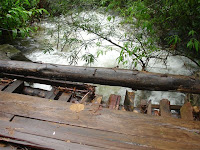
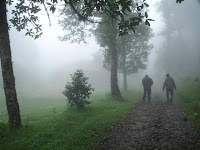
We were welcomed by hot cup of Chai by the caring staff and the cottage key was handed over। Our cottage was slightly far from the main building, inside the forest, which added to the thrill n fun। We became nomadic inside the forest with our camera and the
handy cam, pretty much nothing to do other than capturing the beauty of nature to the maximum।
After a good homely lunch, we again moved out, this time with a guide, deep into the jungle. Only issue was the Leaches all over as it was rainy season, but with the after shave lotions and deo sprays, we won over the leaches.
Though we had plans of visiting all the tourist spots nearby, like the pakshipathalam and bhoothathaankettu, we decided not to move out anywhere and to be inside the jungle only for the whole day. 120 Feet tall treetop house built for tourist by jungle Park
resorts was a major attraction
No words can explain the raw beauty of the jungle in Wayanad and we went on clicking our cameras till the evening.
At night after the dinner, we had a nice time inside the cottage where the power supply stops at 10.30PM. Being in the middle of the jungle with no telephones or televisions to distract was an experience by itself.
The next day we packed our bags to the next destination Mysore। The beauty of the Wayanad forest will remain ever green within our hearts and hey, we recommend this wonderland for all you jungle lovers. Be there, experience and then you will know what I meant.
Hope these few photographs will help you in imagining at least 10% of the fun n frolic we had during our stay.
|
Posted by
Susan Sharma
on
April 12, 2007
Scientists say it has become increasingly clear that worldwide precipitation is shiftng away from the equator and toward the poles.
While rich countries are hardly immune from drought and flooding, their wealth will largely insulate them from harm, at least for the next generation or two, many experts say.
Cities in Texas, California and Australia are already building or planning desalination plants, for example. And federal studies have shown that desalination can work far from the sea, purifying water from brackish aqifiers deep in the ground in places like
New Mexico.
Source: Times International, 3/4/07
|
Posted by
Susan Sharma
on
April 02, 2007
March /April is the time for temple festivals in Kerala where hundreds of elephants are displayed as part of the festivities.
Increasing competition among festival committe owners to showcase the majestic elephants and the clashing of festival dates cause the bid for majestic elephants to go up from Rs 25,000 per day to Rs 50,000.
Despite the soaring demand for elephants, private owners refuse to accept that they are making huge profits. The special feeding and medicare sessions prior to festival time cost upto Rs 2 lac.
Is it time we started looking at some of our traditions more critically?
( economic figures source: The Hindu 1st April)
|
Posted by
Susan Sharma
on
March 26, 2007

It all began two years ago when hundreds of butterflies perished at Muthalamada in Palakkad district of Kerala. The butterflies’ holocaust was followed by the unusual death of cattle in the area. Then came reports that several children were mentally retarded
or crtically ill. The situation was somewhat akin to Swarga in Kasargod where similar cases were recorded after indiscriminate spraying of endosulfan on cashew plantations.
WPSI was the first to raise alarm following the death of butterflies. A health survey of residents within a five-km radius of Muthalamada, found that genetic disorders were prevalent in children born in the past five years and they were susceptible to cancer,
kidney trouble and respiratory ailments. All of them were living close to plantations that had been sprayed with endosulfan.
Though endosulfan is banned in Palakkad, it is clandestinely obtained from neighbouring towns in Tamil Nadu. To stop such clandestine sprayings, environmental groups are demanding a complete ban on endosulfan all over India. All the same, there is no conclusive
medical evidence that endosulfan is behind the maladies of the residents.
When it comes to environment and health of people, isn’t it time we acted on possible causes of harm rather than wait for conclusive evidence?
(Source: The Week, April 2, 2007)
|
Posted by
Susan Sharma
on
March 26, 2007
The milkweed butterflies, indigenous to Taiwan, migrate in late March from Southern Taiwan to the north, where they lay eggs and die. The young butterflies then fly south every November to a warm mountain valley near the Southern part of Taiwan. Conservationists
say Taiwan has about 2 million milkweed butterflies.
To protect the migrating butterflies, a 600 meter stretch of highway in Southern Taiwan’s Yunlin County will be sealed off in the coming days as the migration peaks. Authorities set up nets to make the butterflies fly higher and avoid passing cars. They
will also install ultraviolet lights to guide the insects across a highway overpass.
( Source: The Economic Times, Delhi dated 25 March 2007)
|
Posted by
Vikrant Nath
on
March 14, 2007

*BACKGROUND*
It was but the Fifth Day of the Seventh Year of the Third Millennium. The bright sun on a cold and windy winter morning was divine. The past fortnight at Dudhwa National Park had been completely packed and hectic. And as I drove past the sunny Lakhimpur
town, National Environment Science Camp 2006-07 was finally over. Karavan Heritage and Nature Society had hosted this Camp for several school students from all over the country. The Camp had been a resounding success.
* Just around twelve kilometers from Lakhimpur, en route to Sitapur, lies the village of Mohamdabad. It was here at the jheel near this village that I sighted this huge congregation of Sarus Cranes. I The Sarus is one of the most enchanting sights of the
countryside. A fleeting moment of a real life experience of the wild transcends endless hours of the best wildlife movies or watching animals in captivity. And if you have ever seen the Sarus dance during their courtship, believe me; your life has been worth
living. I counted around 9 pairs that day. I bid farewell to my feathered pals and set off with a resolution that I shall be back here very soon.
*VISITING THE WETLAND ONCE AGAIN* 8:00 AM. 16^th February 2007. The meter gauge passenger train is chugging past the beautiful railway station of Oel. This place is unbelievable. It evokes the romanticism and innocence of a lost age.
*NARMADESHWAR SHIV TEMPLE AT OEL* I begin my brief trek to the Narmadeshwar Mandir, dedicated to Lord Shiva. It is the auspicious occasion of Shivratri today. The temple, popularly referred to the as the Medhak Mandir (Frog Temple), stirred my imagination
a few years ago, when a friend told me about it. I catch a glimpse of the huge dome shaped roof of the temple. It seems quite impressive. I soon reach the gates of the temple. The beauty of earthy brown color of the brick temple is unmatched even by marble
or red sandstone. A small but devout crowd has gathered for worship. I, too, collect a pooja ki thali and step in the temple compound. This temple is awe-striking. It is perhaps one of the most beautiful and possibly one of the oldest living extant temples
in Uttar Pradesh. I have seen far more impressive temples than this. But this temple has a unique identity that distinguishes it from any other temple anywhere. The garb-griha (the sanctum) of the temple has been constructed over a frog shaped structure. It
seems as though a frog is bearing the weight of the temple on its back. The sanctum, located at least 20 feet above the ground level, is accessed by means of steps on all four sides. . Even after many hundred years, the sanctum walls partially retain the old
vibrant colors and floral designs. The devotees have thronged around the Shiva-Linga. The place is pulsating with divine energy. The ambience is both somber and festive. After a while, I offer my obeisance to the Deity and climb down the steps of the temple.
The main temple along with the four surrounding minor temples presents a grand sight. The frog structure and bas-relief sculptures upon the walls appear quite puzzling. The sculptures even though crude make an interesting study. I try to locate a spot where
I can capture the beauty of the entire structure in totality. It is a futile effort. I end with many images of the temple. Full of admiration, I am eager to gather more information about its history and heritage. Luckily, I meet the Rajguru (the Royal Priest)
of the temple.
*HISTORY AND HERITAGE OF THE TEMPLE*
He tells me that this temple has been built by the magnanimous Royal Family of the Oel Estate. The temple, according to him, is Four Hundred Years old. An ancestor of the Royal family found the Shiva-Ling in the holy waters of the River Narmada. It was consecrated
and the temple was raised here. This temple is an invaluable possession of the Family; who refuse to part with it even in the most pressing circumstances. Another very interesting aspect, the Rajguru tells me, is that this is originally a Tantric Temple (like
the famous Khajuraho temples). The sculptures on the temple represent the Tantric symbols. In fact the Frog itself is a Tantric symbol. Vedic practices have long replaced the Tantric traditions. I find all this fascinating and wonder why this great heritage
is shrouded in oblivion!
VISITING THE MOHAMDABAD JHEEL AFTER A MONTH*
It takes me around half an hour to reach there to reach the jheel. There water seems to have receded somewhat. I look for exact spot where I had sighted the Sarus congregation. But this time not a single Sarus is to be seen. “Hard luck,” I mumble to myself,
“perhaps I should have reached here earlier.” But I am not disappointed. I decide to wait for some more time resting underneath the roadside Arjun tree. A Collared Bush-Chat catches my attention. I like her acrobatic sorties from one reed to another. I also
sight some drongos, lapwings and kingfishers. Relaxing lazily underneath a tree shade near a placid lakeside, on a nice sunny day, is a regal pleasure. I partake my share, but soon realize that I have my royal duties to attend to tomorrow. And I’d better reach
the Oel railway station well in time to board the return train to Lucknow. I have hardly walked a 100 meters that I notice four large birds hovering high up in the sky. Their flight indicates that they are preparing to land. I focus my binoculars. . I am eager
to see them land. With their wide wings outstretched and thin long legs pointing towards the earth, they use the air current to encircle the spot they want to land. Though high above the ground, their gradual descent has begun. The afternoon sun pinches my
vision, but how can I ever forgo the sheer joy of this sight! The four paratroopers are now in descent. With every passing moment, they appear larger and larger. And then the touchdown; that is what is called perfect landing. They run a distance, strictly
observing the laws of motion. The birds settle on the jheel and immediately get down to business. Of the four, one bird simply vanishes somewhere. The other three scamper for food. I shake my head in disbelief. They are Sarus! Now I am simply thrilled. While
I observe the Sarus, a few lads ferrying sugarcane on a bullock-cart observe me. They enquire about my pursuit. They tell me that their village jheel is home to many Sarus Cranes. I ask them if they can take me to the jheel.
*THE SARUS CONGREGRATION*
Yet again I savor the delights of rural India, as the bullock-cart rocks ahead to Gajnipur. Upon arrival at the village and during the walk to the jheel, I am joined by many more escorts. My escorts bombard me with a variety questions. They, finally, conclude
that I am a government official making a count of the State Bird of U.P. They emphasize that I must mention Gajnipur in my report. They opine that this might help in the development of their village. Before long, I reach the edge of the village jheel. I wonder
if this is the Shangri-La that the Tibetan mystics talked about. Before my mortal eyes, I behold a large congregation of Sarus, lined as though in a queue. I take a deep breath. This is no dream. A journey that began more than a month back has been fulfilled.
*I count twenty-eight Sarus in the queue. Another pair is seen on another side of the jheel; that makes it thirty. Plus the four at the Mohamdabad jheel, makes it thirty-four in all. Wonderful!** * The villagers tell me that the Sarus is unmolested in this
village. People respect the Sarus and do not harm the bird. I laud their attitude. They feel happy. I tell them I’ll be back. I take a final look. The grace and beauty of the birds leaves me spell bound. I retrace my steps wondering whether the Sarus can survive
the rapacious encroachment of its habitat by the ever expanding sugarcane farms and sugar mills in this region.
|